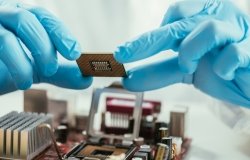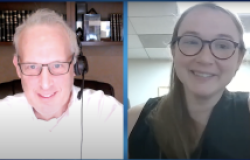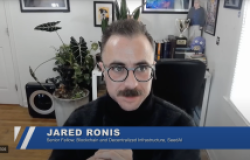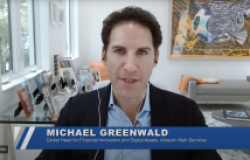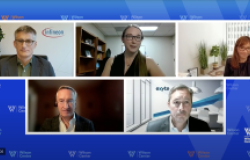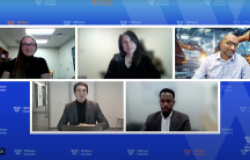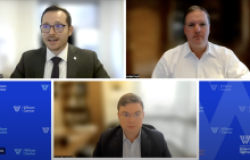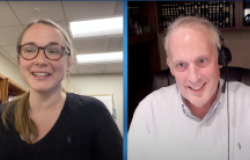The Genetic Age: Who Owns the Genome?
Do companies have the right to patent genetic discoveries? This has become one of the most controversal intellectual property issues of our time. A panel of experts debated the ethical, legal, and financial implications of gene patenting at a recent Wilson Center event.
On the eve of the 50th anniversary of the discovery of the double helix, issues relating to the use of intellectual property in genetic research, medicine and health care have never been more prominent. Chief among these issues is the patenting of human DNA sequences. - Is the patenting of gene sequences necessary to attract capital and protect the rights of inventors? - Are gene patents inhibiting the work of scientists and stifling innovation?
The Wilson Center and Affymetrix Corporation co-sponsored a debate September 24, 2002 titled "Who Owns the Genome?" The event highlighted many of the legal, economic and ethical considerations of this timely and important topic; panelists represented a diversity of backgrounds, experiences and opinions. The event was co-hosted and introduced by the Honorable Lee H. Hamilton, Director of the Wilson Center, and Affymetrix Founder, Chairman, and CEO, Stephen P.A. Fodor, Ph.D. A full transcript of the meeting is available on this site (PDF).
The lively discussion, moderated by Washington Post reporter Justin Gillis, spawned some interesting questions centered upon the current PTO (Patent and Trademark Office) policy of granting patents for identifying pieces of the genetic sequence. The question was whether the traditional argument of 'patents encourage innovation' is applicable when it comes to the human genome. Can we really allow a patent for something that occurs in nature? Although all the panelists agreed that patents are necessary to reward the massive amounts of money, time and research it takes to develop and introduce a successful drug into the market, they did not agree on where to set the bar for granting patents for the products of genetic research.
Panelist Q. Todd Dickinson, JD, who has spent the past 25 years, both in the private and public sector, working on intellectual property law and public policy, discussed the legal history of patenting genetic sequences as well as the criteria an invention must meet in order to qualify for a patent. He argued that, although genes are a chemical composition that occur in nature, if one is able to isolate and purify a specific genetic sequence, as well as establish utility, then it warrants a patent. Dickinson explained the three-part test the U.S. Patent and Trademark Office has established, which requires that the genetic innovation must be specific, substantial, and credible. Dickinson used insulin as an example of an isolated genome than meets all these criteria. Insulin is a natural substance, but identified in its purified form, serves an important purpose. Man-made production of insulin has significantly bettered the lives of diabetics.
Gillis asked panelist Scott A. Brown, JD, why those in the private sector are interested in patenting genetic sequences. As Chief Patent Counsel of Millennium Pharmaceuticals, Brown argued that helping to cure human disease costs money. In order to drive the market, private sector researchers need to see a return; such is the nature of capitalism. Patents allow for that return to materialize, paying for the estimated $500-800 million it costs to introduce one successful drug into the market. Brown strongly supports the current PTO policy of granting patents for pieces of the genetic sequence, as he deems patents the driving force behind innovation in the field of drug making.
Of Tuesday's panelists, the strongest opponent to the current PTO policy was Eric S. Lander, Ph.D. As a biologist, geneticist, mathematician and one of the principle leaders of the Human Genome Project, Lander argued that by allowing for patents of such simple, already occurring in nature, substances, we are in effect, inhibiting future research and progress in a largely unexplored field. He believes in the U.S. patent system, however he feels they have made it too easy, in essence the bar needs to be raised. If we give away patents for too little work society gets a "raw deal." He looks at a genomic patent as a "20-year monopoly" often granted after the completion of the first few steps of a highly automated sequencing process. Lander argued that this situation harms consumers immeasurably.
Gillis looked to panelist Pilar N. Ossorio, Ph.D., JD in an attempt to reconcile the differences between morality and the law. As an ethicist and a lawyer, Ossorio has seen both sides of the academics vs. lawyers' ongoing battle. Taking a moderate tone, she cited misunderstanding as the match that ignited many of the early genetics arguments. She reminded those present that the idea of patent law is to achieve a public good, not just to financially reward the inventor. Along with Lander, Ossorio argued that we need to set the bar where it will best serve the interest of the public. If the criteria for receiving a genetic sequence patent were slightly tightened, the additional stringency may weed out some of the less useful patent applications. With too many patents granted, she asserted, we begin to undermine both the inventions and innovation process.
Related Links
Documents & Downloads
Related Programs

Science and Technology Innovation Program
The Science and Technology Innovation Program (STIP) serves as the bridge between technologists, policymakers, industry, and global stakeholders. Read more

Maternal Health Initiative
Life and health are the most basic human rights, yet disparities between and within countries continue to grow. No single solution or institution can address the variety of health concerns the world faces. By leveraging, building on, and coordinating the Wilson Center’s strong regional and cross-cutting programming, the Maternal Health Initiative (MHI) promotes dialogue and understanding among practitioners, scholars, community leaders, and policymakers. Read more


